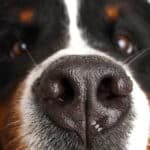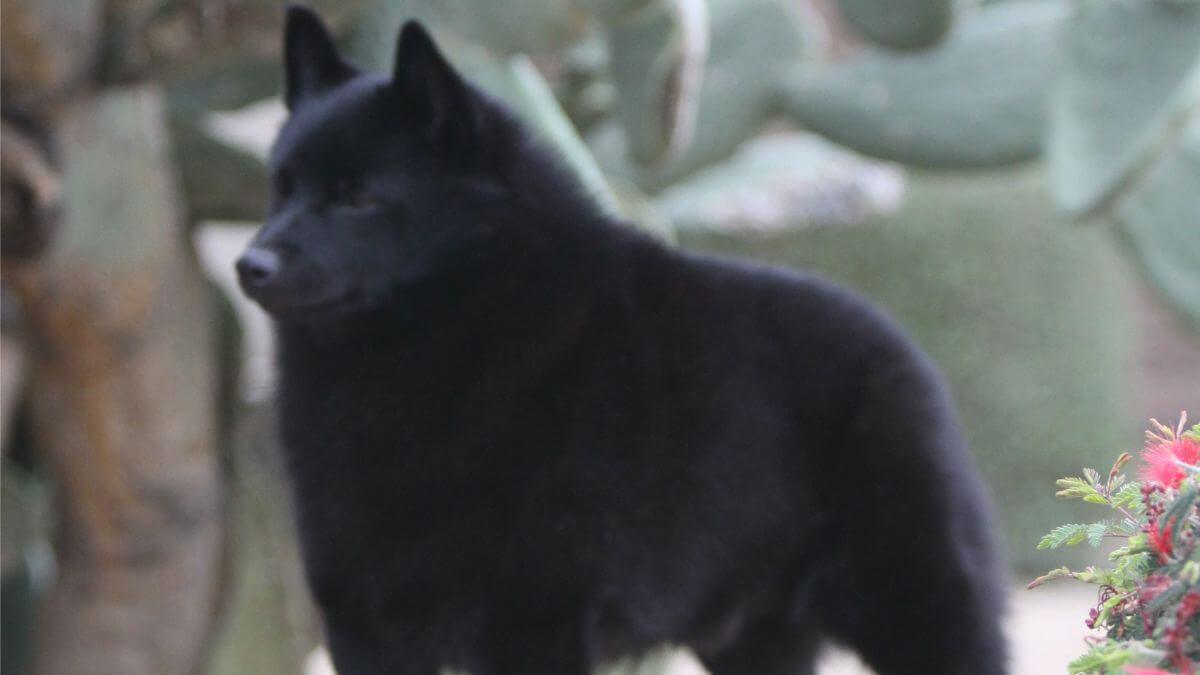
Home » An Expanded Interpretation of the AKC Schipperke Breed Standard

This article was originally published in Showsight Magazine, February 2014 issue.
Alert and curious, the Schipperke has the heart of a terrier in the body of a spitz and may be related to neither. Schipperke means “Little Captain” in Flemish—or possibly the name comes from the Flemish word for shepherd. History is not clear as to the origin. In either case, the breed developed in Belgium in the 1600s as ratters and guards on canal barges. At times, they rode the backs or nipped at the heels of horses that pulled the barges along the canals. On land, the dog kept rats out of shops.
Although the Schipperke’s impudent character, foxy face, upright ears, and thick coat denote a spitz-type heritage, breed historians claim the dog descended from the Leuvenaar, a Belgian herding dog that also produced today’s Belgian Sheepdog. The Belgian herding dog of those days weighed about 40 pounds, smaller than today’s version, and could well have been the ancestor of both breeds. It has been said that only the wealthy in those days could own the larger dogs, so the Schipperke was used as a “poor man’s herding dog.”
Whatever its origin, the Schipperke has an interesting history. Initially owned by shopkeepers and tradesmen, the little dog had its own specialty show in 1690. That show and subsequent competitions featured elaborate copper collars designed for the dogs. The breed didn’t catch the attention of the upper classes until the mid-1800s when Queen Marie Henriette, wife of Leopold II of Belgium, saw a Schipperke at a Brussels show and bought the winner. For most of the rest of the century, the Schipperke was virtually the only house dog in Belgium.
The English discovered the Schipperke about the same time and imported many dogs from Belgium. The “Little Captain” came to the US by the end of the century. The breed was recognized by the AKC in 1904.
The Schipperke is an agile, active watchdog and hunter of vermin. In appearance, he is a small, thickset, cobby, black, tailless dog, with a fox-like face. The Schipperke is often referred to as a “big” dog in a small package—especially in his own mind. When judging the breed, the dog should “feel heavy” and have plenty of body under the coat. The terms “thickset and cobby” refer to the body and overall appearance of the dog.
The dog is square in profile and possesses a distinctive coat, which includes a standout ruff, cape, and culottes. All of these create a unique silhouette, appearing to slope from shoulders to croup. This is a silhouette breed! If the Schipperke does not have the proper coat and silhouette, it is NOT an ideal Schipperke! The unique silhouette and coat pattern are what makes the Schipperke different from any other breed!
Males are decidedly masculine without coarseness, while bitches are decidedly feminine without over-refinement. The Schipperke should NEVER appear overdone or over-refined!
The Schipperke may have a sloping or level topline. Both are equally correct. The stand-out ruff adds to the slope, making the dog seem slightly higher at the shoulders than at the rump. Because of the heavy coat, one must put hands on the dog in order to know if the topline is level or has a slope to it. Occasionally, there are faulty dips in the topline (usually at the shoulder) which can be hidden by the coat and skillful grooming, but this will usually show itself when the dog is moving.
Schipperkes are slow to mature, and the “thickset” appearance becomes more obvious with age. It is not uncommon to find the top-ranked special dogs in our breed that are veterans.
Correct pattern is an essential breed characteristic! The adult coat is highly characteristic and must include several distinct lengths growing naturally in a specific pattern. The texture is slightly harsh to the touch. The coat is short on the face, ears, front of the forelegs, and hocks. It is medium-length on the body, and longer in the jabot, ruff, cape, and culottes. The ruff begins in back of the ears and extends completely around the neck. The cape forms an additional distinct layer extending beyond the ruff. The first distinct line you see is the ruff, the second line is the cape. The jabot extends across the chest and down between the front legs. The coat on the rear of the thighs forms culottes, which should be as long as the ruff.
The hair down the middle of the back, starting just behind the cape and continuing over the rump, lies flat. It is slightly shorter than the cape but longer than the hair on the sides of the body and legs. Lack of differentiation in coat lengths should be heavily penalized, as it is an essential breed characteristic! Coat pattern is obvious in all Schipperkes, even those out of coat or young puppies. Undercoat is necessary in the Schipperke, as it is what makes the ruff stand out. The undercoat should be dense on the body, and very dense on the ruff.
While the overall dog must be black, the undercoat can be black, or an “off color,” usually grey or a slight reddish brown. Occasional stray white hairs are permissible (Schipperkes tend to grow white hairs where they have been injured and scarred in the past—this typically shows on faces if a dog has been involved in rough puppy play or fights). Graying, due to age in the Veteran dog (7 years) is permissible, but should be faulted in younger specimens.
The coat should be abundant and straight. Coats may take on a reddish cast during the shedding period, which usually occurs twice a year (spring and fall) or in many breeders’ experiences—about two weeks after they’ve been entered in a show! Pattern can still be seen even when the dog is out of coat. Silky coats, body coats over 3″ or very short harsh coats are equally incorrect! Trimming of the Schipperke’s coat is not allowed!
In recent years, there has been a fashion of trimming the underline of the dog (sometimes done to “neaten the underline” and sometimes done to create the illusion of longer leg on a short-legged dog), trimming or stripping out the coat on the rear to “create” a sloping topline and/or the illusion of a square dog out of a dog that is long in body, and stripping or trimming away the culottes. If a Schipperke adult is walking away from the judge and the coat appears to be grey, the judge may want to check to see if that coat has been trimmed.
While it is understood judges have a choice, the Schipperke Club of America prefers that a Schipperke with a tail be considered a serious deviation from the standard and prioritize and penalize it accordingly. The standard says, “The Schipperke is an agile, active watchdog and hunter of vermin. In appearance he is a small, thickset, cobby, black, tailless dog, with a fox-like face. The croup is broad and well-rounded with a tail that is docked. No tail is visually discernible.” Any deviation from the ideal described in the standard should be penalized to the extent of the deviation. The docked tail is an essential breed characteristic.
When considering the Schipperke head and expression, the expression is questioning, mischievous, impudent, and alert, but never mean or wild. The well-proportioned head, accompanied by the correct eyes and ears, will give the dog the proper Schipperke expression. The skull is of medium width, narrowing toward the muzzle. Seen in profile with the ears laid back, the skull is slightly rounded. The upper jaw is moderately filled in under the eyes, so that, when viewed from above, the head forms a wedge, tapering smoothly from the back of the skull to the tip of the nose. The stop is definite but not prominent. The length of the muzzle is slightly less than the length of the skull. The skull is slightly rounded when viewed from the side.
The ideal eyes are small, oval rather than round, dark brown, and placed forward on the head. The eyes should never be prominent or bulging, but will sometimes take on a more rounded appearance when the Schipperke is excited or nervous.
The ears are small, triangular, placed high on the head, and, when at attention, very erect. The following are less than ideal: The ear itself should not tip backwards or forward, the tips should not point inward or outward, belled ears, or long and thin ears. The bite must be scissors or level. Both the scissor or level bite are equally acceptable! Any deviation is to be severely penalized.
In evaluating the Schipperke’s structure when viewed from the front, the elbows remain close to the body. The legs form a straight line from the shoulders through the elbows to the toes, with the feet pointing straight ahead. From the rear, the legs should form a straight line from the hip to the hocks to the pads, with the feet pointing straight ahead.
The key to the rest of the dog and the overall appearance of the Schipperke is balance! The standard calls for the front to be placed well underneath the dog, the shoulders to be well laid back, and a slight bend to the pasterns when viewed from the side. The rear should APPEAR slightly lighter than the front but is well muscled and in balance with the front. Extreme rear angulation is to be penalized. Suggested height is 10-12 inches, with no more than 1″ in deviation from that.
Our Breed Standard only has two disqualifications: Drop ear or ears, and any color other than a natural black. Schipperkes excel in many venues, whether it be obedience, agility, rally, tracking, search and rescue, therapy work. Tey truly are very versatile little dogs!